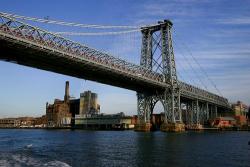
When opened in 1903, the 1,600 foot long main span of the Williamsburg Bridge was the world's longest suspension span, surpassing the nearby Brooklyn Bridge by only 4.5 feet. The Williamsburg Bridge remained the world's longest suspension bridge span for 21 years until the opening of the Bear Mountain Bridge in 1924. The Williamsburg Bridge has two unsuspended side spans of 596.5 feet, each supported from below by trussed towers, giving the bridge an overall length of 2,793 feet. The four main suspension cables are 18.75 inches in diameter and each composed of over 10,000 wires. The Williamsburg Bridge uses steel towers in place of the massive masonry towers used on prior major suspension bridges, such as the Brooklyn Bridge.
The Williamsburg Bridge originally carried four trolley lines, two elevated rail lines, four carriage lanes and two pedestrian walkways, making it amongst the most heavily loaded bridges ever built. The bridge superstructure was stiffened by two parallel trusses each 40 feet deep and hinged at the main towers. The Williamsburg Bridge was the last major suspension bridge designed using the "elastic theory," and its exceptionally deep truss is a result of the approximations included in this theory. Substantial increases in suspension bridge spans would not be possible until the application of the "deflection theory" - first used on the nearby Manhattan Bridge.
Proposals for a second bridge crossing of the East River began in the late 19th century, even before completion of the Brooklyn Bridge. The design of the Williamsburg Bridge began with the appointment of Leffert L. Buck as chief engineer in 1895 and construction began in 1896. As with other New York bridges, the design and construction of the Williamsburg Bridge became intertwined with New York politics. In 1902 Mayor Seth Low appointed Gustav Lindenthal as Bridge Commissioner, and Lindenthal proceeded to reassign the duties of the lead engineers for the Williamsburg Bridge, as well as the Manhattan and Queensboro Bridges. With the construction well along, Lindenthal still attempted to modify the design of the Williamsburg Bridge, but was ultimately prevented from doing so by the intervention of Mayor Low. The Williamsburg Bridge opened on December 31, 1903 - Low's last day as Mayor; and Lindenthal's, as Bridge Commissioner.
Primarily the work of Chief Engineer L. L. Buck, the structural design of the Williamsburg Bridge included contributions from R. S. Buck, O. F. Nichols and H. D. Robinson - all leading bridge engineers of the late 19th and early 20th centuries. The architect Henry Hornbostel also contributed to the design of the bridge.
Resource
- Griggs, F.E. "Leffert L. Buck and the Williamsburg Bridge" unpublished manuscript.


